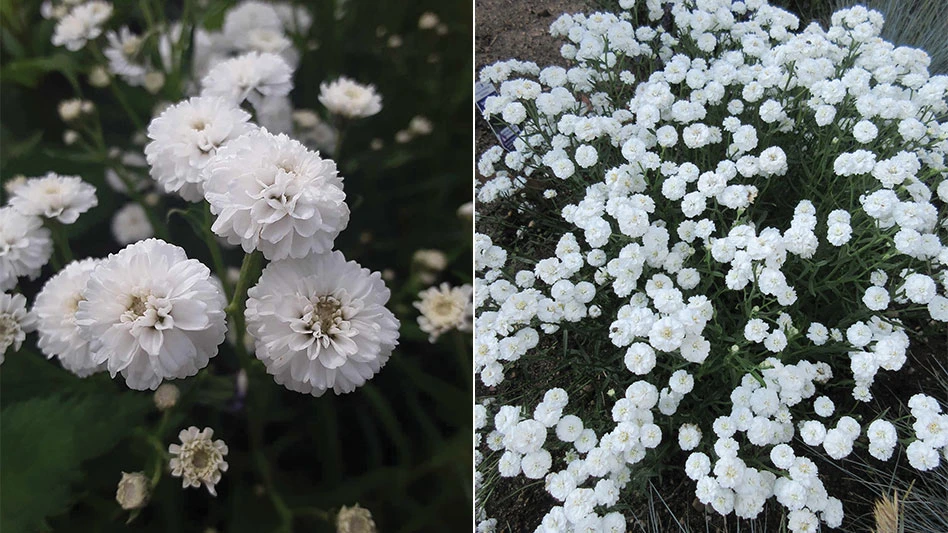
Protecting plants during propagation can be a challenge. Unrooted cuttings and young seedlings generally require warm temperatures, along with frequent misting or high humidity, so they can root into the planting media. However, this warm, humid environment also provides optimal conditions for spores of pathogenic agents to germinate, invading wounds and tender plant tissue.
Plants in propagation can be at risk of developing various diseases, including foliar blights caused by Botrytis cinerea, leaf spots caused by Alternaria, Colletotrichum and Myrothecium spp., as well as lower stem rots. Young seedlings are also at risk of damping-off from Pythium, Phytophthora and Rhizoctonia spp. when the growing media is wet for a prolonged period of time.
“It’s crucial to identify diseases early during propagation,” says Nancy Rechcigl, technical services manager for ornamentals at Syngenta. “Proper cultural practices and preventive fungicide applications can help growers keep a successful crop throughout production. If preventive strategies are not put in place, growers may have to resort to curative applications, which are costly and not as successful.”
Start strong. Stay protected.
Mural® fungicide is a broad-spectrum option for greenhouse and nursery growers to combat these destructive diseases during propagation. It is labeled to control more than 50 ornamental diseases, including Botrytis, leaf spots, rusts, powdery mildew and many soil-borne diseases. Mural offers the flexibility for use as a spray or a drench, providing effective disease protection in propagation and after transplant.
Mural contains two active ingredients, both of which have unique characteristics and benefits that can protect young plants.
“Resistance can be a concern when it comes to fungicides. Rotating modes of action has become more important than ever to treat diseases,” says Rechcigl. “With two active ingredients in FRAC groups 7 and 11, Mural is ideal for incorporating into rotation programs for protection against a wide variety of pathogens.”

One of the two active ingredients in Mural, azoxystrobin, is in the strobilurin class of chemistry, which also provides plant health benefits. Azoxystrobin is systemic and offers xylem mobile movement, meaning it is absorbed by the plant and translocated upward to protect new growth.
Mural also contains Solatenol® fungicide, an advanced generation SDHI (succinate dehydrogenase inhibitor) that binds to the waxy layer of plants and slowly penetrates the tissue, creating a barrier of protection. Mural inhibits spore germination and mycelial growth, providing plant protection inside and out.
In addition to its fungicide activity, azoxystrobin affects physiological processes within plants that result in plant health benefits. Strobilurin fungicides have been shown to:
- Lower rates of transpiration in plants, maximizing the efficiency of water use.
- Reduce ethylene production, which helps delay senescence, so leaves stay greener longer, resulting in more efficient photosynthesis. This leads to increased production of carbohydrates within the plant, which improves growth and plant vigor.
- Increase nitrate reductase levels in plants, allowing nitrates to be more readily available for the production of proteins essential to plant growth.
“Plant health effects, such as root enhancement, are more often seen at lower use rates with strobilurin chemistries. The higher the use rate, the less likely root benefits will be observed,” says Rechcigl. “Mural is labeled at a rate of 4 oz. for foliar and 2-3 oz. for drench applications. At these low rates, it provides broad-spectrum disease control and offers plant health benefits, like increased root density.”
Improved root development has been observed when Mural is applied as a drench to protect plants from root and stem diseases caused by Rhizoctonia solani, Sclerotium rolfsii and Pythium spp. These benefits are due to positive effects on plant physiology, which can vary according to plant species and growing environment.
Recent trials conducted at Ohio State and Michigan State Universities have shown that Mural is providing effective protection against black root rot (Thielaviopsis basicola),which can affect a wide range of annual and perennial crops. Plant development and quality are severely reduced once this pathogen invades and establishes in a root system that is left unprotected. Additional trials are being conducted this year to further assess the activity of Mural on this pathogen.
By applying a fungicide drench of Mural during propagation, you can help prevent the onset of diseases while also experiencing the plant health benefits of its strobilurin chemistry.

Mural is labeled for use in greenhouse and nurseries and can be applied to vegetable transplants grown for resale to consumers. Its broad-spectrum activity and two active ingredients make it a powerful option for fungicide rotation programs to help keep crops clean.
Learn more at www.GreenCastOnline.com/PlantHealth
Syngenta does not recommend or endorse making applications solely for physiological benefits or using reduced rates (lower than labeled) for physiological effects.
Get curated news on YOUR industry.
Enter your email to receive our newsletters.
Explore the July 2018 Issue
Check out more from this issue and find your next story to read.
Latest from Nursery Management
- Dümmen Orange North America celebrating 25th anniversary in 2025
- Redesigning women
- Illinois Landscape Contractors Association changes name to Landscape Illinois
- 2025 Proven Winners Horticulture Scholarship applications now open
- ICL’s Gemini Granular herbicide now registered for use in California
- Eurazeo Planetary Boundaries Fund acquires Bioline AgroSciences
- The Leading Women of Horticulture
- Leading Women of Horticulture: Dana Massey, Plantworks Nursery






